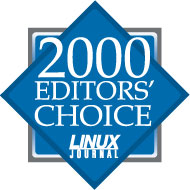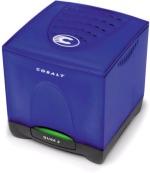Editors' Choice Awards

As reported in the 1999 Editors' Choice Awards, it's been another year of bursting developments and blossoming advancements for our favorite operating system. Not only is Linux becoming the hot OS of embedded environments, but the first year of the new millennium has witnessed the expiration of the RSA patent, allowing open-source security tools to be included in Linux distributions. The SourceForge site, furnished by VA Linux has quickly become perhaps the most valuable resource for programming tools and information. More attention than ever is being paid to the penguin OS as a desktop alternative by large corporations and venture capitalists who are finally beginning to understand the free business model and are, happily, coming to accept the GNU GPL instead of coming up with their own incompatible licenses. Additionally, an increasing amount of previously proprietary software is becoming open source, such as Sun's StarOffice, now free under the GNU GPL. All this translates to an ever-enlarging field of competitors for the Editors' Choice Awards. And not only are there more entries than ever, but almost all entries are increasing in quality and functionality, making the choice of our favorites akin to deciding on a drink at an open bar with a one-drink limit. Sure you can have that Tom Collins, but only at the expense of the White Russian. If some of our choices rub you wrong, make it a stiff one and be reconciled.

We know, we know, we should have picked the rackmount version of this easy-to-configure server. The “RaQ” is the one that people have been buying by the truckload. But we like the cube shape. It's so...cubical. The whole thing just works, even for people who aren't Linux experts. It was the happy, new users who clinched our decision in favor of this box. Read the QubeQuorner weblog if you want to see some of the stuff that the user community (Quommunity?) is up to.
VA Linux Systems has a good reputation for getting good hardware and installing Linux on it. Last year, they got ambitious, designed their own easy-open 2U chassis, and filled it with hot-swap RAID drives and other quality parts. This year, the puzzle is complete, as they put Debian on the latest 2200 series servers. Now you can upgrade your software as easily as you swap a drive.
Everybody has been jumping up and down at how clueful IBM has become in the Linux department. But why change the name of the System/390? That's like renaming the battleship Iowa. But silly name or not, you have to love a server that lets you start up a whole new instance of Linux for a project without even going down to the server room to run another Ethernet cable.
Except for a loud fan in the preproduction system we tested, we like this box a lot. It's put together well from top-quality components and supported by a small, friendly company. The CPU is AMD's Duron, the cheap version of the celebrated Athlon, and we like the well-supported Matrox video card and the reliable IBM hard drive too. Just the thing for running the new, free StarOffice, or designing your new web site.
Frankly, nobody has yet shown us a high-end Linux workstation that has really knocked our socks off. The Linux workstation industry is still in its infancy, and good 3-D support still requires some tweaking and RTFM-ing. So, socks still firmly on our feet, we visited elinux.com, browsed their selection of Linux-compatible parts and built our own workstation. Maybe next year there will be a workstation that impresses us right out of the box, but we'll still like elinux.com for important stuff like SCSI cards and name-brand RAM.
Early this year, we heard quite a bit about privacy abuses by the web advertising agency Doubleclick. So rather than getting “pushed, filed, stamped, indexed, briefed, debriefed or numbered” by their global-tracking database, we've installed privacy protection software: the Internet Junkbuster Proxy.
If you travel with your laptop, put a copy on it too. Not downloading banners can make hotel dial-up speeds tolerable.
Neither of our two choices for best graphics application even has a GUI interface. Sometimes you need to script something, and converting any unlicensed GIFs you may have lying around to the legal PNG format is one of those times.
gif2png includes a script to grovel through your entire site and expunge the GIFs once and for all. And, some software creates oversized PNGs when you “save as PNG”, and pngcrush can go back and do it right.
There is a large selection of backup tools for Linux, and we're glad, because it makes it easier to back up your new Linux box where the Powers that Be have already chosen the backup software to be used.
At Linux Journal though, we run Amanda. We can get whatever software we want at no charge because software companies give us copies to butter us up. But our sysadmin team chose Amanda, which stands for “Advanced Maryland Automatic Network Disk Archiver”. There's an unrelated project called Amanda at Berkeley, so be sure not to install the wrong software—the Berkeley Amanda is the Antarctic Muon and Neutrino Detector Array, and you don't want to find yourself with a bunch of muon-tracking data instead of backups of your files.
Amanda is classic, old-school free software—infinitely configurable, not fancy, but reliable. It takes a while to learn and set up, but once you've got it configured the way you want, it should be trouble-free.
In an earlier article we wrote, “Jabber is built so wide open that it's hard to see the limits of what can be done with it.” And we like the “explosive combination” of XML and instant messaging. With Jabber, any two identities, whether human or machine, can send and receive real-time messages that contain pretty much anything and can do so in a structured way, independent, if necessary, of intermediating protocols. Jabber is going to be the basis of some fun applications.
Think of Blender as the planter for the render farm—it's the application that lets you design 3-D scenes. But fire it up and you'll quickly realize that Blender is no Xpaint. This is some heavy software and takes a real-time investment to learn. But we judge a tree by its fruits, and digital art produced with Blender is pretty impressive.
Tim Perdue, a well-known PHP wizard, explained the benefits of using PostgreSQL as a back-end database for his web projects: “To start, we will make use of Postgres' SELECT...FOR UPDATE syntax, which effectively locks selected rows so you can update them and commit your changes within a transaction.”
And, he adds, “With some databases, like MySQL, you can't easily lock specific rows of data to prevent other processes from decrementing the inventory while you are also trying to decrement the inventory. What you wind up with is inaccurate numbers and a useless inventory count.” Now, we can't have that. If your e-commerce site sells the last Furby twice, you're in big trouble.
For “big-database” features and the configurability and administration advantages of open source, we give PostgreSQL a big thumbs-up.
If you invest your time and money in a computer game, you want to see people suffer when you shoot them, right? Anatomically correct gunshot wounds. Screams of agony. Simplistic plot. Put it all together and what do you get? Hours of fun, that's what.
Weak stomach? Try GNOME Freecell.
We must confess something right now. Here at Linux Journal, we're just not big office suite users. We basically get by with vi until we send articles to layout, and when someone sends us a proprietary-format document, we just trash it and add them to the bozo list. But every once in a while, in our personal lives, we have to do up a batch of anti-DMCA flyers or something. For that, there's StarOffice. A bit on the hoggish side, but it gets the job done. And we'll buy beers for Sun people at the next Linux show—thank you for putting the new version under the GPL.
Remember how Matt Suhey didn't rap on the “Super Bowl Shuffle” but he gained a bunch of yardage, including a touchdown, in Super Bowl XX? KDE is the Matt Suhey of the Linux desktop. Despite the attention paid to a certain other desktop project this year, we're most impressed with the stability and just plain well-thought-outitude of KDE. KWord is a promising word processor, and all the desktop doodads work well too. Most of us at Linux Journal run KDE.
Troll Tech ended up fixing the KDE licensing mess with the stroke of a pen, but the next licensing controversy could go the other way, if the company involved turns out to be less cool than Troll Tech. So, kids don't try the license incompatibility thing at home.
By the way, that's Super Bowl 0x14 for those of you who aren't NFL fans.

Tuxtops is in a strange position, halfway between being a hardware vendor like VA Linux Systems and being a Consumer Reports for Linux laptops. They're too small to influence manufacturers' hardware selections, so they have to take the best laptop they can get and put customized software on it. But Tuxtops is a refreshing burst of honesty in a shrink-wrapped world.
We like their “Coming Clean” pages, in which they list the inadequacies in the hardware they ship. One page points out that one system's Lucent modem is “cranky and temperamental”, even with the supplied Linux driver, and advises buyers to “ignore this hardware and consider it vestigial”. Thank you; I'll get the optional PCMCIA modem instead of wasting my time. Funny, the more bad things you say about your products, the better you look.
The Microwindows demo was one of our favorites at LinuxWorld. Imagine a GUI project that includes X- and WinCE-compatible APIs, alpha blending, proportional fonts, handwriting recognition, a VNC client, a Minesweeper clone and more. Now imagine it in 100K. Can you say Linux PDAs? Better put a waterproof cover on them; we're drooling.
RedBoot is an embedded debug and bootstrap tool for running embedded Linux systems on embedded platforms including ARM, MIPS, MN10300, PowerPC, Hitachi SHx, v850 and x86. It supports booting from flash or from the network.
RedBoot provides ways to address real-time timing requirements that allow an application to respond quickly to real world needs. It also provides some important tools to debug in this environment, which in our opinion is an extremely important issue. It is also completely open source.
Meow! This free bar code scanner was handed out at Radio Shack and included with some magazines (not ours). Not only did people dissect the kitty to disable its serial number (see the November 2000 issue) but they also wrote drivers and decoders to use it for all kinds of things, including cataloging their vast book collections.
The CueCat's manufacturer got into the fun by having their lawyer send out some of the most pointless and ludicrous threatening letters I've ever seen, which naturally made everyone get more CueCats to find out what all the fuss was about.
Apparently the original purpose of the CueCat was to get people to scan magazine ads instead of typing URLs, which must save some companies the trouble of learning HTTP Redirects. But, out of dumb business models come nifty toys.
The Linux Network Administrator's Guide, by Olaf Kirch and Terry Dawson, has been a “living document” from the Linux Documentation Project since 1993 and still contains one of the best introductions to TCP/IP we've ever read. The new edition, released this year, is relevant to more Linux users than ever, since more and more of us are getting broadband Internet connections and setting up home networks instead of just using a PPP dialup. For users looking to take advantage of their DSL or cable connections, we recommend this book, which is available from the Linux Documentation Project web site.
Once there was Usenet News and Linus Torvalds announced Linux there. Then many threads of discussion moved to lists, and web discussion boards, but forum after forum of intelligent conversation was stormed and destroyed by flamers and idiots. This year's chosen web site, Advogato, has been surprisingly jackass-free and has given us thoughtful discussions on password-protected textbooks, GNU autoconf, Bill Joy and choosing the right C data types to make your code 64-bit clean. Advogato is ruled by the cold equations of a reputation-ranking system, which has, so far, worked to protect it from the tide of drivel that washes over the rest of the “community” sites.
As a bonus, the Apache module that powers Advogato is fast, free and in our humble opinion, elegant.

+Product of the Year: TiVo
If you think Linux isn't ready for end users, well, put the TiVo in your pipe and smoke it. It's this year's hottest home theater component—a Linux-powered box that actually lets you “pause” and “fast-forward” live TV. No more waiting for a commercial to get another beer.






